
- Subject:
- Applied Science
- English Language Arts
- Health, Medicine and Nursing
- Reading Foundation Skills
- Material Type:
- Lecture
- Provider:
- CUNY Academic Works
- Provider Set:
- Kingsborough Community College
- Author:
- Limandri, Dina
- Date Added:
- 05/27/2014

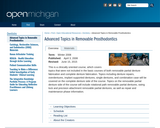
This is a clinically oriented course, which covers topics that were not included in the basic courses of both removable partial denture fabrication and complete denture fabrication. Topics including denture repairs, overdentures, implant supported dentures, single dentures, and combination case will be covered on the complete denture side of the course. Topics on the removable partial denture side of the course will include rotational path removable partial dentures, swing lock and precision attachment removable partial dentures, as well as repair and maintenance phase information.

This 7-week lesson plan is designed for use in clinical nursing courses. It is designed specifically for use by Nursing faculty teaching in the absence of state required patient facing clinical opportunity due to COVID restrictions. The lesson plan describes pedagogical techniques and provides video and education OER resources designed to help support the development of empathetic communication skills over 7 weeks. Refection and video debriefing techniques will be employed. Role play will culminate in the group presentation project of a brief video modeling effective therapeutic empathetic communication.
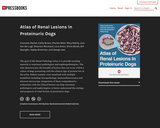
The goal of this Renal Pathology Atlas is to provide teaching material to veterinary pathologists and nephropathologists. The atlas demonstrates the breadth of lesions that can occur within a cohort of dogs presenting with the clinical sign of protein loss in the urine. Kidney samples were examined with multiple modalities including: histopathology, immunofluorescence and electron microscopy. Integration of these comprehensive evaluations with the clinical history can help veterinary pathologists and nephrologists to better understand the etiology and prognosis of renal lesions in proteinuric dogs.
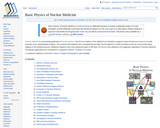
Nuclear Medicine is a fascinating application of nuclear physics. The first ten chapters of this wikibook are intended to support a basic introductory course in an early semester of an undergraduate program. They assume that students have completed decent high school programs in maths and physics and are concurrently taking subjects in the medical sciences. Additional chapters cover more advanced topics in this field. Our focus in this wikibook is the diagnostic application of Nuclear Medicine. Therapeutic applications are considered in a separate wikibook, "Radiation Oncology".

Biomedical research today is not only rigorous, innovative and insightful, it also has to be organized and reproducible. With more capacity to create and store data, there is the challenge of making data discoverable, understandable, and reusable. Many funding agencies and journal publishers are requiring publication of relevant data to promote open science and reproducibility of research.
In order to meet to these requirements and evolving trends, researchers and information professionals will need the data management and curation knowledge and skills to support the access, reuse and preservation of data.
This course is designed to address present and future data management needs.

This is a voicethread explaining big data and its attributes. The presentation describes the various sources of data. A discussion thread allows students to correlate the impact of data to healthcare. It also provides considerations related with the use, storage and security when sharing big data.
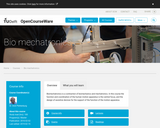
Biomechatronics is a contraction of biomechanics and mechatronics. In this course the function and coordination of the human motion apparatus is the central focus, and the design of assistive devices for the support of the function of the motion apparatus.
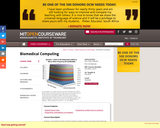
Analyzes computational needs of clinical medicine reviews systems and approaches that have been used to support those needs, and the relationship between clinical data and gene and protein measurements. Topics: the nature of clinical data; architecture and design of healthcare information systems; privacy and security issues; medical expertsystems; introduction to bioinformatics. Case studies and guest lectures describe contemporary systems and research projects. Term project using large clinical and genomic data sets integrates classroom topics.
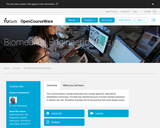
This course presents a design philosophy and a design approach, dedicated to rehabilitation technology. This field was selected because of human-machine interaction is inherent and vital. Illustrative examples will be discussed by their entire design process
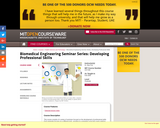
Seminars exploring current research and topical issues in the biomedical sciences, addressed at the general theme of innovation. Seminars are organized in blocks with related content, and are presented by prominent outside speakers as well as by HST faculty members and graduate students. Each seminar block includes several semi-weekly presentations, in addition to wide-ranging discussions among speakers, faculty, and students. Discussions involve issues such as relations between presented research areas, requirements for further advances in the "state of the art", the role of enabling technologies, the responsible practice of biomedical research, and career paths in the biomedical sciences. This course consists of a series of seminars focused on the development of professional skills. Each semester focuses on a different topic, resulting in a repeating cycle that covers medical ethics, responsible conduct of research, written and oral technical communication, and translational issues. Material and activities include guest lectures, case studies, interactive small group discussions, and role-playing simulations.

Seminars exploring current research and topical issues in the biomedical sciences, addressed at the general theme of innovation. Seminars are organized in blocks with related content, and are presented by prominent outside speakers as well as by HST faculty members and graduate students. Each seminar block includes several semi-weekly presentations, in addition to wide-ranging discussions among speakers, faculty, and students. Discussions involve issues such as relations between presented research areas, requirements for further advances in the "state of the art", the role of enabling technologies, the responsible practice of biomedical research, and career paths in the biomedical sciences.
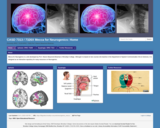
Mecca for Neurogenics is a site developed by Prof. Sharon Beaumont-Bowman of Brooklyn College. Although it is based on two courses she teaches in the Department of Speech Communication Arts & Sciences, it is designed as an interactive repository for many resources on Neurogenics.
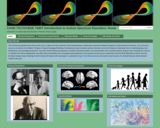
This introductory graduate level three-credit course is taken in the first semester of the interdisciplinary, collaborative Advanced Certificate Program in Autism Spectrum Disorders. The course also serves as an elective in the Master’s Program in Speech-Language Pathology. Contemporary issues in autism spectrum disorders across the lifespan are addressed from an interdisciplinary, inter-professional cross-paradigm perspective. Key units include historical perspectives on autism, theoretical models, core characteristics and co-morbid features, lifespan issues including the concerns of families from diverse backgrounds, and ASD culture and identity from a strengths-based perspective. The resources on this site are curated links from the World Wide Web as well as from the Brooklyn College Library. Readings from BC Library will require a BC email login; it is advisable to log in to the library reources at the start of each session. For external links you will be directed outside of this site.
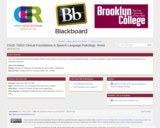
Addresses foundational knowledge related to many aspects of clinical practice in speech-language pathology. It has been developed to support students entry into their first clinical practicum and supervision experience.

Syllabus for Healthcare in US at Kingsborough Community College

This is the syllabus for a Health Care Coordination course.
The goal of health care coordination is to improve patient outcomes with better health care services. Care coordinators play a critical role in improving patient care. Students will learn how to effectively advocate for patients and interact with members of the healthcare team in finding solutions to provide high quality, value-based, and efficient care. Effective communication styles, assessing patient’s needs and goals, and helping with patients’ transitions of care are among many topics covered in this course. Upon course completion, students will have acquired basic knowledge and skills to educate, engage, and support patients and their health care teams to improve health outcomes and quality of life.

This syllabus includes OER materials and college policies for a fully online course that exposes students to a range of health promotion and disease prevention and management strategies used by health specialists to address community health challenges. Through readings and videos, as well as online course assignments and discussions, students learn about planning and designing interventions to improve the health of specific priority populations and communities-at-large.

The COPD Primer begins with an examination of what COPD is; it is really a syndrome, a constellation of historical features and clinical, physiologic, and radiographic findings. However, those elements come together in many different ways to create multiple different COPD phenotypes that are only now being recognized and used to define specific management strategies. COPD research has progressed beyond the simple classification of “blue bloaters” and “pink puffers.” Next, the epidemiology and economic consequences of COPD are reviewed. Bill Eschenbacher presents an approach to the patient with respiratory symptoms with detailed discussions of pulmonary function testing and how airflow limitation/obstruction is identified by spirometry and the use of lung imaging to identify individuals with COPD. Michael Borchers and Gregory Motz summarize current evidence implicating genetics, proteolytic imbalance, oxidative stress, inflammation, occupational and environmental exposures, and innate and adaptive immune function in the pathogenesis of COPD and the implication of these findings to future treatments. The single most important intervention in the prevention and treatment of COPD is smoking cessation. Shari Altum, Katherine Butler, and Rachel Juran present a practical approach to smoking cessation utilizing motivational interviewing in combination with pharmacologic interventions. Then, they expand upon these concepts to provide practitioners with convenient, realistic suggestions to encourage patient self-management in all aspects of COPD care and overall health. Ahsan Zafar reviews the natural history, recently described COPD phenotypes, and gender differences that clearly illustrate the broad spectrum of disease that comprises the term, COPD. The cover illustration highlights Dr. Zafar’s creative and artistic talents. The extensive nonpulmonary aspects of COPD are reviewed by Ralph Panos in an examination of COPD’s multi-organ manifestations. Next, the effect of COPD on sleep and the overlap syndrome, the concurrence of COPD and obstructive sleep apnea, and its consequences are presented. Jean Elwing examines the effect of COPD on the pulmonary vasculature with a detailed discussion of the evaluation and management of pulmonary hypertension associated with COPD. COPD’s effects on psychosocial functioning and familial interactions are presented by Mary Panos and Ralph Panos.

Two of the core competencies designated for The First Year Seminar Liberal Arts Math and Science (LMF 101) course are Integrative Learning and Global Learning along with oral communication. These abilities are exercised by students in the Career/Interview Presentation project. The main goal of the assignment is to promote student networking within the scientific community through interviews with an expert in the field. Also the FYS students will conduct background research about their career choices and use their findings to determine if they can be realized when interviewing a professional. The assignment is scaffolded whereby students will learn to use on-line resources to search for information about the profession and use on-line tools to material in preparation for the interview. Students will learn how to write professional emails, network and create PowerPoint slides. After the class presentation, students are asked to write a reflection in their ePortfolio on their career choice and interview experiences. The time dedicated for this project is on the order of weeks and counts for 20% (15% oral presentation and 5 % reflection) of the final grade.